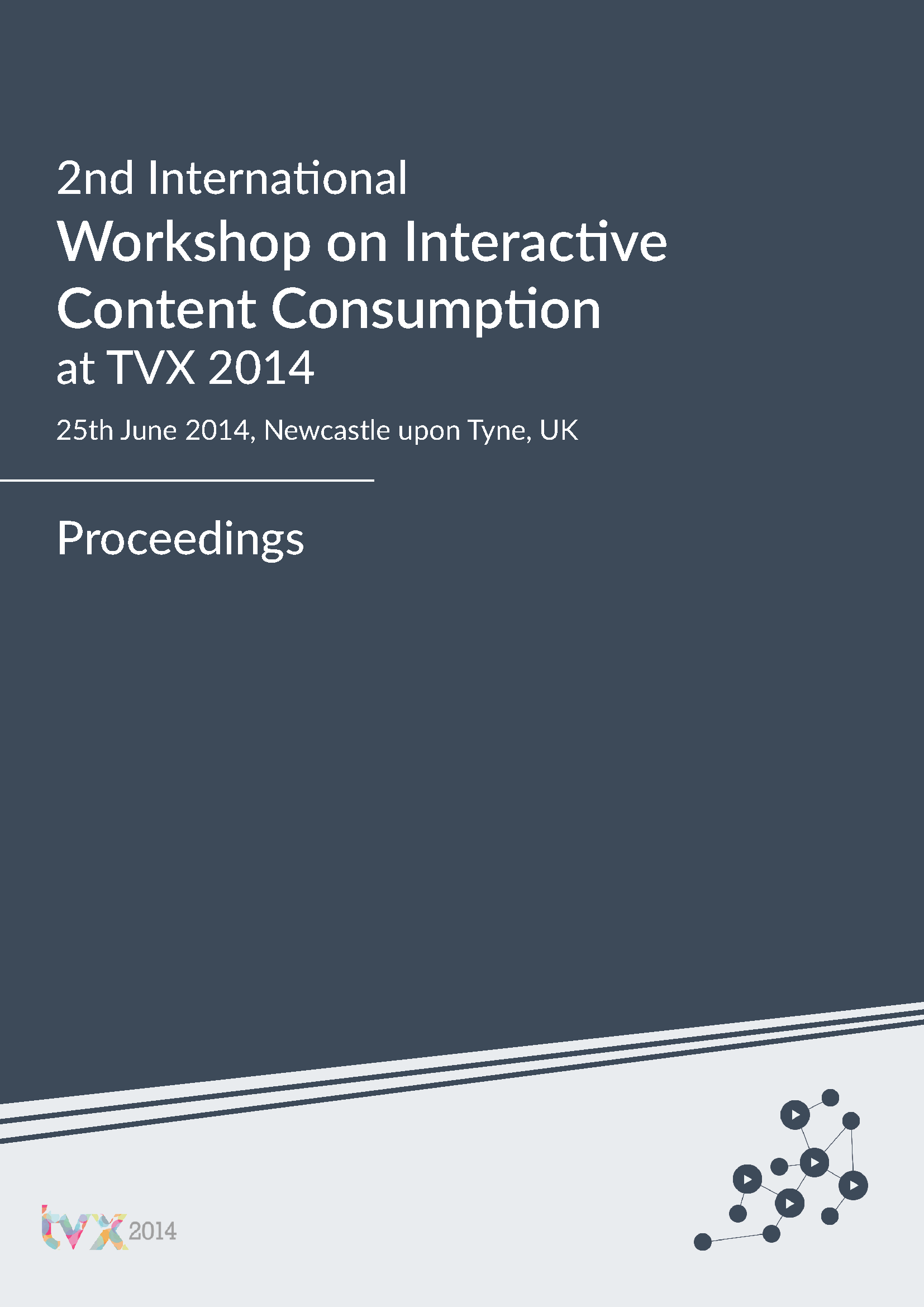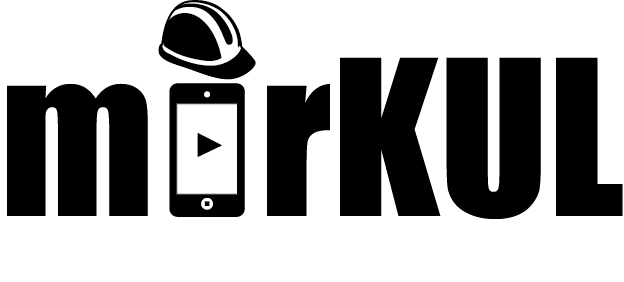2nd International
Workshop on Interactive Content Consumption
at TVX 2014
25th June 2014, Newcastle upon Tyne, UK
Special Issue on "INTERACTIVE MEDIA: TECHNOLOGY AND EXPERIENCE"
Springer Multimedia Tools and Applications (MTAP) Journal
Submit your Manuscript by
More Info / Call for Papers (PDF)
All papers should be full journal length versions (18 - 30 pages) and follow the MTAP guidelines.
Proceedings
Keynote
Invited keynote by Prof Marian Ursu:
Blurring Boundaries: Intelligent Video Interaction
Poster / Demo Session
- Rinze Leenheer and David Geerts
Using Overlays and Second Screen to Stimulate Social Interaction Without Compromising Passive ConsumptionCreating a good interactive TV experience that does not compromise the ‘regular’ TV experience is no simple task. We propose a combination of second and first screen to offer a social-interaction stimulating, interactive experience that is completely optional. First observations and interviews have been completed. The next steps are a series of prototypes and a field pilot test in the Netherlands. - Thomas Fritzsche, Stefanie Müller, Arne Berger and Maximilian Eibl
Location Based Video Flipping: Interactive Prototype navigated by HbbTV remote controlWe present a geospatial navigation concept for browsing videos according to their tagged geographic location. The proposed application is derived from two modi operandi for selecting video content: While continuous, yet onedimensional flipping through listed video clips can be controlled with a regular HbbTV remote control, the discrete selection of video clips that are positioned on maps according to their tagged location is usually done with mouse and cursor. The proposed concept combines the ease of use of a remote control in a lean-back setting and the precision of selecting videos on maps. - Robert Strzebkowski
HbbTV-based Augmented Information Television with Segment-linked Related Content on TV and 2nd ScreenIn this paper, new options are presented for seamless connection and synchronization between linear – passive / lean back - Television broadcasts and interactive – lean forward - online multimedia content as well as 2nd Screen applications. Based on two project examples it will be shown and solutions discussed concerning scene- & segment-based synchronization between the content of information/news/documentary or children TV broadcasts and related additionally 'stretched' online content as well as interactive applications – both on TV and/or on 2nd Screen. The projects and examples are based on the emerging interactive TV standard HbbTV – Hybrid Broadcast Broadband TV. A mixed passive / interactive consumption approach is an important issue here. [...] - Wolfgang Weiss and Rene Kaiser
Vconect - Orchestration for Group VideoconferencingCurrent videoconferencing systems show a lack of support in adapting visual remote camera presentation to the users’ needs. Some manage to put focus on the current speaker. In this demonstration we show an automatic decision making component in the realm of social video communication that aims to go beyond that. Our approach takes into account several aspects such as the current conversational situation, conversational metrics of the past and device capabilities to make decisions on the visual representation of available video streams. This allows to optimally support users in communication within various communication contexts. - Britta Meixner, Stefan John, Christian Handschigl and Harald Kosch
Using the SIVA Suite as a Multimedia Help System for Technical Applications in SMEIn this demo paper we present how the SIVA Suite can be used as a multimedia help system for technical applications in SMEs. After describing our use case, a mechanics scenario, we show how our software was extended to fit all requirements of this scenario. We present short overviews over each component of the SIVA Suite: the authoring tool, the player, and the server application. Thereby, important new features are described briefly. - Fabien Grisard, Sema Alacam and Ceren Kayalar
Social Documentary: An interactive and evolutive installation to explore crowd-source media contentThis paper aims to present a project in progress, an interactive installation for collaborative manipulation of multimedia content. The proposed setup consists in a vertical main screen and a horizontal second screen, which is used as control panel, reproducing an augmented physical desktop. Augmented reality markers are used to give the user an intentional way to interact with the system and a depth camera is used to estimate the users’ gaze and quantify how interested they are in the displayed content, slightly modifying the video projection itself. - Jangsun Lee, Jieun Kim and Hokyoung Ryu
I Remember/Know/Guess What I Saw: A False ‘Belief’ Technique to Features SelectionIn this position paper we address issues with the primary decision problem in the Smart TV UI design – feature selection. While the existing feature selection methods that traditionally make up HCI research were not able to render what features are to be prioritised in the new TV design, we will introduce the ‘False belief technique’ for this advancement. This new experimental technique will greatly enable UI/UX researchers to conduct feature selection evaluations that could effectively examine a users’ schema of the smart TVs, in a rather unconscious way at the expense of extra training time, which are unimaginable before. - Jeroen Vanattenhoven, David Geerts and Dirk De Grooff
Television Experience Insights from HbbTVIn this position paper we shortly highlight the most important results from the European research project HBBNEXT that concludes in March 2014: an ethnographically inspired user study provided many insights into the ways people use second screens; an experiment comparing gesture, voice, and remote control with Microsoft’s Kinect showed that remote control still performs best, that voice looks very promising, and that gesture is useful in certain instances; an experiment with 51 participants validated four novel Social User Experience measures for the (user) evaluation of Group Recommender systems. Finally, we briefly outline our research agenda for another European research project, TV-RING, which started in September 2013. Both research projects focus on novel concepts and applications using the HbbTV Standard.
Research Papers / Talks
- Britta Meixner, Emanuel Berndl and Harald Kosch
Using SIVA XML and SMIL for Interactive Non-linear Videos: a ComparisonWith recent technologies, it is possible to create appealing multimedia presentations or extended videos with a high level of interactivity. Standards like SMIL provide extensive structures to describe metadata for timing and spacing of single media elements which then form a presentation. While multimedia presentations are viewed mainly in a linear manner, provide interactive and non-linear videos a much higher level of interactivity and navigational possibilities. In this work, we examine the expressiveness of SMIL for the support of interactive non-linear videos. It has to describe temporal and spatial relationships of videos and annotations, as well as interaction and navigational elements. We therefore compared SMIL with the SIVA XML. We tried to find ways to express SIVA XML structures with SMIL attributes and elements. After that, we compared the DTD/XSD of SMIL and SIVA XML using XML metrics. We thereby focus on the language implementations. We do not take their implementations in authoring tools or players into account. Concluding that SMIL has little disadvantages in terms of feasibility for interactive videos, we propose minor additions that could resolve these problems and make SMIL more appropriate for our use case. - John Dowell, Sylvain Malacria and Sean O'Halpin
Concept mapping second screens to augment understanding of science on televisionScience programmes on television are the main source for public understanding of science; they also make some of the greatest demands of TV viewers. Companion second screens running on connected, handheld devices have the potential to augment viewers’ understanding of science programmes, for example by providing additional explanations or additional information about the programme. We examine two prior exemplars of second screen designs that were explicitly created to support viewer understanding of programme content. They suggest primary representational functions that a second screen should provide if it is to augment understanding of science TV programmes. We describe an interactive concept map as a second screen that shows promise for achieving those representational functions. - Sérgio Serra and Teresa Chambel
Towards Multimodal Consumption of Georeferenced Mobile Video Using Shape and SpeedAn increasing amount of digital video is accessed, captured, and uploaded to the Web everyday, from different platforms and devices, that increasingly can georeference the information they capture and access, allowing to enrich their contextualization. But video search has been limited to keywords, or a set of parameters, providing limited support for temporal and spatial dimensions. We propose novel ways to search and access georeferenced videos, where these dimensions are of central importance, especially by video trajectories shape and speed, using a multimodal interactive mobile interface, involving gestures and movement, with the potential for more natural interactions, increased engagement, sense of presence and immersion. The preliminary evaluation based on low-fidelity prototypes and encouraging users participation in the design, had positive results. Users found most features quite satisfactory, even fun, and easy to use. Different options and modalities were found interesting and adequate for different use scenarios that could be identified and suggested, and some concerns and challenges were identified to be taken into account in the next design and development phases, towards more flexible and effective interactive content consumption, through more natural interaction with mobile devices on their own or as second screens.

Impressions












More photos can be found at:
http://filmicweb.org/hypervideo-web/2nd-workshop-interactive-content-consumption-acmtvx/

Download Proceedings without posters
[PDF, 2.5 MB]
Program
9:30 - 10:00
Welcome and presentation of workshop aims. Interactive participant introduction in Barcamp style (name, affiliation, 3 keywords to communicate interest and focus).
10:00 - 10:45
Invited keynote by Prof Marian Ursu: Blurring Boundaries: Intelligent Video Interaction
10:45 - 11:00
Short pitches (1min, 1 slide each) to kickstart poster / demo session
11:00 - 11:15
Coffee Break
11:15 - 11:45
Poster / demo session
- Rinze Leenheer and David Geerts
Using Overlays and Second Screen to Stimulate Social Interaction Without Compromising Passive Consumption - Thomas Fritzsche, Stefanie Müller, Arne Berger and Maximilian Eibl
Location Based Video Flipping: Interactive Prototype navigated by HbbTV remote control - Robert Strzebkowski
HbbTV-based Augmented Information Television with Segment-linked Related Content on TV and 2nd Screen - Wolfgang Weiss and Rene Kaiser
Vconect - Orchestration for Group Videoconferencing - Britta Meixner, Stefan John, Christian Handschigl and Harald Kosch
Using the SIVA Suite as a Multimedia Help System for Technical Applications in SME - Fabien Grisard, Sema Alacam and Ceren Kayalar
Social Documentary: An interactive and evolutive installation to explore crowd-source media content - Jangsun Lee, Jieun Kim and Hokyoung Ryu
I Remember/Know/Guess What I Saw: A False ‘Belief’ Technique to Features Selection - Jeroen Vanattenhoven, David Geerts and Dirk De Grooff
Television Experience Insights from HbbTV
First fishbowl discussion
12:30 - 14:00
Lunch break
14:00 - 15:30
3 research paper based talks:
- 14:00
Britta Meixner, Emanuel Berndl and Harald Kosch
Using SIVA XML and SMIL for Interactive Non-linear Videos: a Comparison - 14:30
John Dowell, Sylvain Malacria and Sean O'Halpin
Concept mapping second screens to augment understanding of science on television - 15:00
Sérgio Serra and Teresa Chambel
Towards Multimodal Consumption of Georeferenced Mobile Video Using Shape and Speed
Coffee Break
16:00 - 17:00
Second fishbowl discussion
17:00 - 17:30
Concluding session
Call for Papers / Participation
This workshop focuses on novel forms of interactive content consumption. It will explore the shifting balance between lean-back passive TV and Web media consumption and lean-forward interactivity. Beyond entertainment, interactive audiovisual content has a high potential for learning and support scenarios. An interdisciplinary view on the topic shall be compiled by contributions from technical research, conceptual work, user-centric studies, industry developments, as well as experimental showcases. Below, some of the questions that the workshop aims to answer are listed:
- How can forms of (inter-)active media access be designed to be interwoven with passive consumption modes?
- How does the balance between active and passive consumption affect the Quality of Experience?
- How can active and passive content consumption foster learning?
- How can content personalization be enhanced through interactivity, and at which abstraction level do users want to interact?
- What do studies on interaction with content in the realm of social media sharing reveal?
- Do trends in content consumption behavior influence technical research by revealing new challenges?
The workshop is seeking 3 types of submissions: full research papers for presentations (4-6 pages), short papers for poster oral presentations and technical demos (2 pages). Presentation slides or short videos can be submitted in addition to the short papers for posters and demos. At least one author of each accepted paper must attend the workshop and all participants must register for the TVX conference.
Download [PDF]Important Dates
17th March 2014
Final Version Due
29th April 2014
Workshop @ ACM TVX2014:
June 25th 2014
Submission Details
Workshop Format
We have developed a workshop format to stimulate networking and knowledge transfer among the participants. The full 1 day workshop will be an active forum to discuss research challenges, methodologies and results in a field that is gaining attention based on quickly changing content consumption needs and habits. More than half the time will be reserved for discussion. The chairs will establish an informal atmosphere, inspired by Barcamps. In an active moderating role, they will make sure the workshop’s questions will be answered and documented, yet will allow some flexibility where appropriate to meet the interest of the audience. Results will be collected on flip charts along multiple questions which emerge throughout the day, e.g. what are the latest innovations in that field? Which research activities exist to tackle unsolved challenges? How could we combine different interaction technologies to the benefit of the user? Throughout the day, the audience will be encouraged to contribute, and especially to comment existing inputs (I’d love to collaborate on this!... This has already been solved in my project!). The outcome of the highly interactive part of the workshop will be summarized on a poster for the presentation at the main conference.
Program Comittee
- Olivier Aubert, University of Nantes, FR
- Teresa Chambel, Universidade de Lisboa, PRT
- Maria Da Graca Pimentel, Universidade de Sao Paulo, BR
- Mario Doeller, FH Kufstein Tirol, AT
- Michiel Hildebrand, Centrum Wiskunde & Informatica, NL
- Joscha Jaeger, Merz Akademie Stuttgart, DE
- Rene Kaiser, JOANNEUM RESEARCH Forschungsgesellschaft mbH, AT
- Jieun Kim, Hanyang University, KR
- Oge Marques, Florida Atlantic University, US
- Britta Meixner, Passau University, DE
- Christan Menkens, IBM, CA
- Omar Niamut, TNO, NL
- Lyndon Nixon, MODUL University Vienna, AT
- Wei Tsang Ooi, National University of Singapore, SG
- Marc Ritter, TU Chemnitz, DE
- Patrice Rondao Alface, Alcatel Lucent Bell Labs, BE
- Graham Thomas, BBC, UK
- Katrin Tonndorf, Passau University, DE
- Joerg Waitelonis, Hasso-Plattner-Institute Potsdam, DE
- Goranka Zoric, ABB Corporate Research, Västerås, SE
Organizers
Britta Meixner is a researcher at the Passau University. She received a diploma in computer science and a state examination for lectureship at secondary schools from the University of Passau, Germany, in 2008. Currently, she is working towards a PhD degree in computer science at the Faculty of Computer Science and Mathematics of the Passau University. There, she is conducting research and development in the area of hypervideo. Thereby, she focuses on creating easy to use authoring tools and players and on download and cache management to provide a better viewer experience. Further she is interested in hypervideo on mobile devices, collaborative hypervideo creation, and decision rules in hypervideo. Britta is a member of the BMBF research project “Mirkul” that investigates application scenarios of interactive nonlinear video. Britta is a reviewer for the Multimedia Tools and Applications Journal (Springer) and was a member of the program committee of the 1st International Workshop on Interactive Content Consumption at EuroITV 2013.
Katrin Tonndorf is a researcher at Passau University. She received a magister degree in media studies from the Technical University Braunschweig and the Braunschweig University of Arts in 2010. Currently, she is working towards a PhD degree in communication studies at the Faculty of Arts and Humanities at the Passau University. She is conducting research in the area of online and social media communication practices. Furthermore she is interested in the use of interactive audiovisual content for learning und support purposes. Katrin is also a member of the BMBF research project “Mirkul”.
Rene Kaiser is a key researcher for JOANNEUM RESEARCH and has been involved in a number of European projects dealing with automation of content production such as NM2, Aposdle, TA2 and Vconect. His research focus is on Virtual Director software, on automating shot selection through cinematographic behavior models. Further he is interested in automating non-linear video production, enabling the user to interactively influence the narrative path while watching. Rene was responsible for the organization of the Interactive and Immersive Entertainment and Communication Special Session at MMM’12. He is part of a group hosting the annual PhD cooperation workshop at the i-KNOW and i-SEMANTICS conference, active member of STCSN, and has been organizing the Barcamp Graz, a yearly 3-day unconference which is an interactive and open discussion format. At EuroITV 2013, Rene was co-organizing the first edition of WSICC.
Joscha Jaeger is a research assistant at Merz Akademie Stuttgart and founder of filmicweb - Hypervideo Interface Design. His research covers web-based hypervideo technology, time-based interaction and semantic video search interfaces. Joscha has a strong focus on film as information architecture, collaborative editing systems for non-linear film and user-driven annotation systems. He is interested in finding new ways of distributed interaction with open video technologies and interfaces on the web.
Contact
meixner@fim.uni-passau.de



